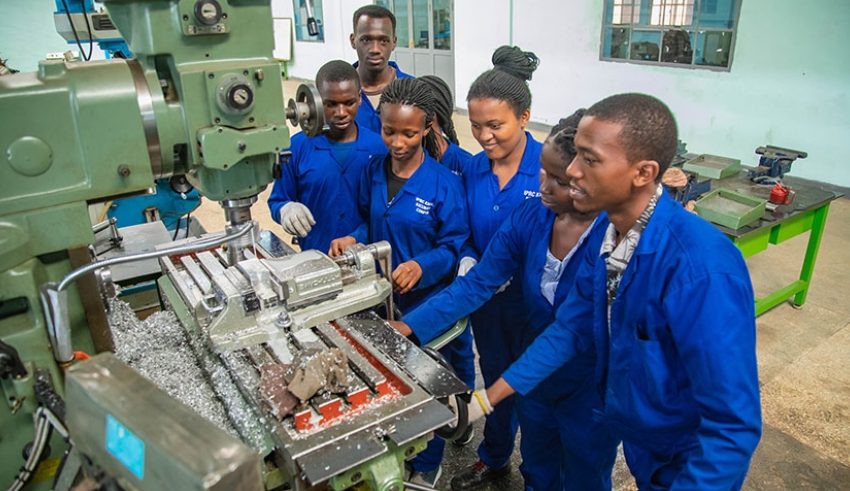
Road towards gainful employment: The Dual TVET approach
- TVET prepares and equips students with technical skills that are essential and practical in the market.
- The dual approach to training under TVET is revolutionary to vocational education as it blends classroom learning with industry experience, equipping students with practical skills and theoretical knowledge.

(Since 2017, KAM has been promoting youth employment through entrepreneurship and skills development. This is through a TVET program that aims at bridging skills mismatch and gap, prevalent in the industry by enhancing skills development and providing a pool of technically skilled personnel at entry and mid-level.)
On 19th October 2022 and 3rd June 2023, the Kenya Association of Manufacturers (KAM) had the privilege of presenting its views on job creation to H.E. the President, Dr William Ruto, CGH. During the presentation, we took the President through manufacturing value chains and demonstrated that job opportunities in manufacturing are in hundreds of thousands. However, most of these jobs will be for those with requisite technical skills.
As the dust settles on 2023 Kenya Certificate of Secondary Education (KCSE) results and students start considering various career pathways, many find themselves at a crossroads, their academic fates sealed by a set of grades. In an era defined by the dynamic employment landscape, the conversation around post-KCSE choices must extend beyond university gates. The evolving employment landscape demands a fresh perspective, one that champions the pragmatic alternative of Technical and Vocational Education and Training (TVET).
Back in the day, crossing the threshold into university was a monumental achievement, celebrated with cheer and communal pride. The conventional white-collar jobs that were once the epitome of success no longer hold the same appeal in today’s job market. Blue-collar jobs, fuelled by technical skills, have taken centre stage, turning the job market into a battlefield of opportunities. Hence, equipping oneself with technical skills becomes a formidable weapon, setting job seekers apart in a fierce struggle against unemployment. This dynamic is prominently observable in sectors like manufacturing.
A recent report by the International Labour Organization paints a challenging picture of the global employment scenario, with rising unemployment rates and a growing disparity between high and low-income countries. The report underscores the persistent shortage of skilled labour in sectors such as manufacturing, construction, and ICT, highlighting the urgent need for a paradigm shift in our approach to education. With such revelations, we must rethink our stance on education and explore TVET, more so dual training, a revolutionary approach to vocational education that blends classroom learning with industry experience, equipping students with practical skills and theoretical knowledge. This dual-pronged strategy is a dynamic remedy for the skills gap, a key contributor to escalating unemployment rates.
Consider the striking contrast between the demand for white-collar positions and the reality of the job market. Let me take you down memory lane. In 2023, there was a security company that had advertised for 150 slots seeking to employ Kenyans in positions like courier clerks, controllers, customer service, security officers, and credit controllers, among others. This led to thousands of Kenyans forming lengthy queues in hopes of securing a position. On the flip side, the manufacturing sector in Kenya, specifically, has a significant demand for skills such as welding, plumbing, electrical installation, machine operators, mechanical technology maintenance, and the operation of heavy and light machinery, among others. However, the pressing question remains: What proportion of graduates possess the capabilities to take up such critical roles?
The Fourth Industrial Revolution emphasizes the importance of Science, Technology, Engineering, and Mathematics (STEM) skills, signalling a shift toward a more technical job market. This is where TVET comes in, as it prepares and equips students with technical skills that are essential and practical in the market.
Let us take the case of the manufacturing sector. Since 2017, KAM has been promoting youth employment through entrepreneurship and skills development. This is through a TVET program that aims at bridging skills mismatch and gap, prevalent in the industry by enhancing skills development and providing a pool of technically skilled personnel at entry and mid-level. Through the program, the Association has successfully linked Kenyan manufacturers with skilled labour, actively participated in curricula review and development to address the skills mismatch, established learning communities that foster collaboration between training institutions and employers, and consistently advocated for policy changes on the national skills agenda.
In 2019, KAM implemented the pilot phase of the Dual Technical and Vocational Education and Training Program (Dual TVET), a component that significantly expanded the reach and effectiveness of the TVET Program. Grounded in competence-based curricula, this dual model strategically aligns the training plans of Technical Training Institutions (TTIs) with the dynamic demands of the industry. The project has already shown impressive outcomes, with over 1,500 youths participating in technical skill programs. Notably, 1,260 have successfully transitioned into gainful employment, marking a significant reduction in the skills mismatch that has historically affected our local workforce. These numbers represent not just statistics but transformed lives, demonstrating the tangible success of the Dual TVET Program.
The potential for job opportunities is immense, especially for youth equipped with the technical skills demanded in the country. As the second-largest formal employer in Kenya, the manufacturing sector is committed to the ambitious goal of increasing the sector’s contribution to GDP to 20% by 2030, as outlined in the Kenya Manufacturing 20by30 Strategy, subsequently generating 1 million jobs by 2030. This serves as a compelling invitation for KCSE students to consider technical education as they plan on their next move.
As the Class of 2023 contemplates its next steps, it is crucial that they remember that success has more than one doorway. Embracing TVET is not just a choice; it is a commitment to a brighter and more promising future, where knowledge, skills, and hands-on experience converge on the path to success.
The writer is the Chief Executive of Kenya Association of Manufacturers and can be reached at ceo@kam.co.ke.









